Analysis of Financial Performance and Investment Appraisal
VerifiedAdded on 2020/02/05
|16
|3811
|33
Report
AI Summary
This report provides a comprehensive analysis of financial performance and investment appraisal techniques. It begins with an examination of the financial and non-financial performance of Next Plc and H&M, utilizing various financial ratios and non-financial performance indicators to assess their strengths and weaknesses. The report includes charts illustrating the financial performance of both companies and offers recommendations to the Certified Financial Manager of Asol Ltd regarding investment decisions. Furthermore, the report delves into investment appraisal techniques, including net cash flow, payback period, and accounting rate of return, and applies these tools to a case study involving Hilltop Ltd. The analysis culminates in recommendations for senior management at Hilltop Ltd, along with justifications for the chosen investment strategies, and also discusses the limitations of ratio analysis and investment appraisal techniques.

ACCOUNTING AND
FINANCE
1 | P a g e
FINANCE
1 | P a g e
Paraphrase This Document
Need a fresh take? Get an instant paraphrase of this document with our AI Paraphraser
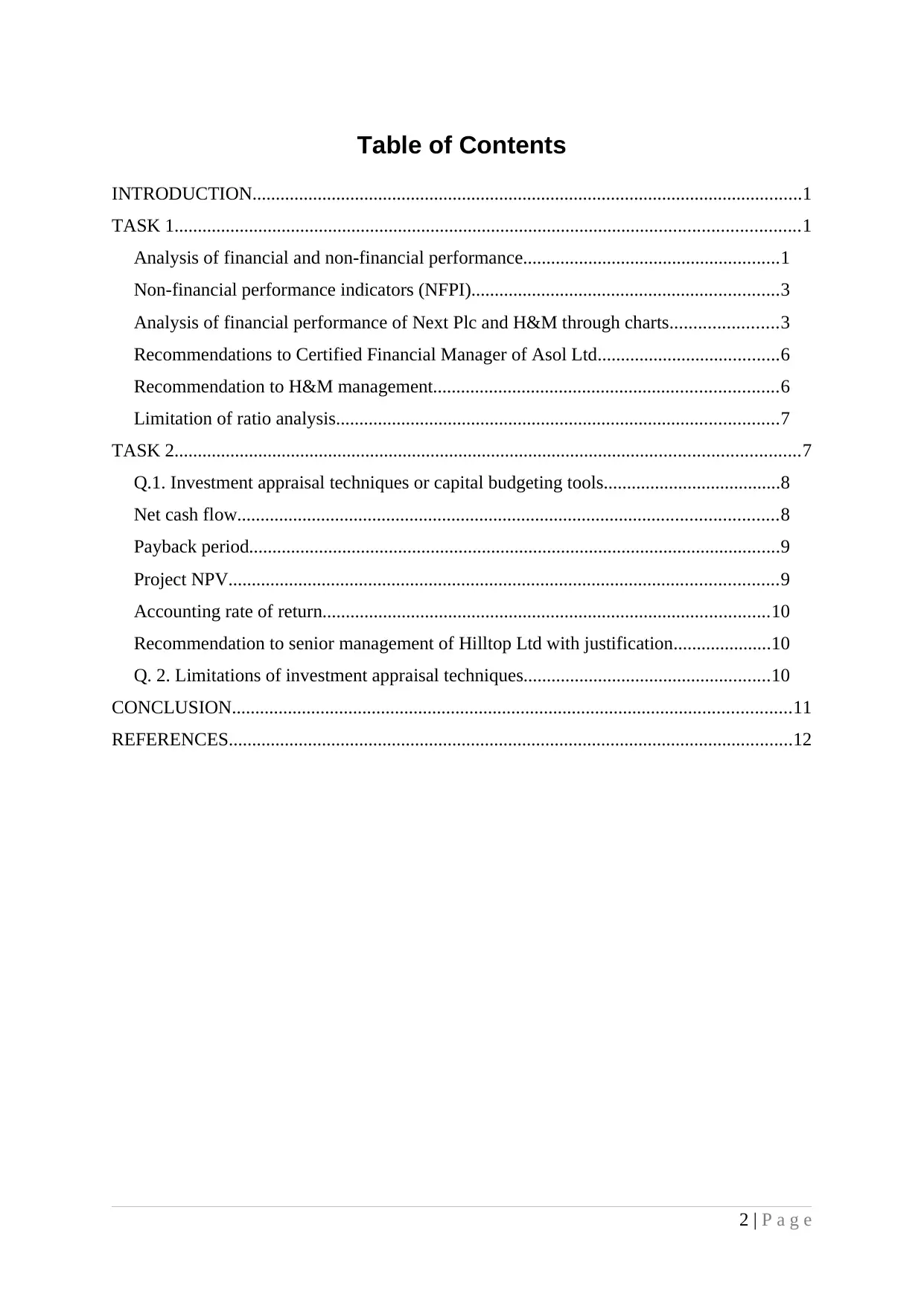
Table of Contents
INTRODUCTION......................................................................................................................1
TASK 1......................................................................................................................................1
Analysis of financial and non-financial performance.......................................................1
Non-financial performance indicators (NFPI)..................................................................3
Analysis of financial performance of Next Plc and H&M through charts.......................3
Recommendations to Certified Financial Manager of Asol Ltd.......................................6
Recommendation to H&M management..........................................................................6
Limitation of ratio analysis...............................................................................................7
TASK 2......................................................................................................................................7
Q.1. Investment appraisal techniques or capital budgeting tools......................................8
Net cash flow....................................................................................................................8
Payback period..................................................................................................................9
Project NPV......................................................................................................................9
Accounting rate of return................................................................................................10
Recommendation to senior management of Hilltop Ltd with justification.....................10
Q. 2. Limitations of investment appraisal techniques.....................................................10
CONCLUSION........................................................................................................................11
REFERENCES.........................................................................................................................12
2 | P a g e
INTRODUCTION......................................................................................................................1
TASK 1......................................................................................................................................1
Analysis of financial and non-financial performance.......................................................1
Non-financial performance indicators (NFPI)..................................................................3
Analysis of financial performance of Next Plc and H&M through charts.......................3
Recommendations to Certified Financial Manager of Asol Ltd.......................................6
Recommendation to H&M management..........................................................................6
Limitation of ratio analysis...............................................................................................7
TASK 2......................................................................................................................................7
Q.1. Investment appraisal techniques or capital budgeting tools......................................8
Net cash flow....................................................................................................................8
Payback period..................................................................................................................9
Project NPV......................................................................................................................9
Accounting rate of return................................................................................................10
Recommendation to senior management of Hilltop Ltd with justification.....................10
Q. 2. Limitations of investment appraisal techniques.....................................................10
CONCLUSION........................................................................................................................11
REFERENCES.........................................................................................................................12
2 | P a g e

Index of Tables
Table 1: Calculation of Net cash flow of project A (In £000's).................................................8
Table 2: Calculation of Net cash flow of project B (In £000's).................................................8
Table 3: Computation of payback period of project A and B (In £000's)..................................9
Table 4: Project Net present value (In £000's)...........................................................................9
3 | P a g e
Table 1: Calculation of Net cash flow of project A (In £000's).................................................8
Table 2: Calculation of Net cash flow of project B (In £000's).................................................8
Table 3: Computation of payback period of project A and B (In £000's)..................................9
Table 4: Project Net present value (In £000's)...........................................................................9
3 | P a g e
⊘ This is a preview!⊘
Do you want full access?
Subscribe today to unlock all pages.

Trusted by 1+ million students worldwide
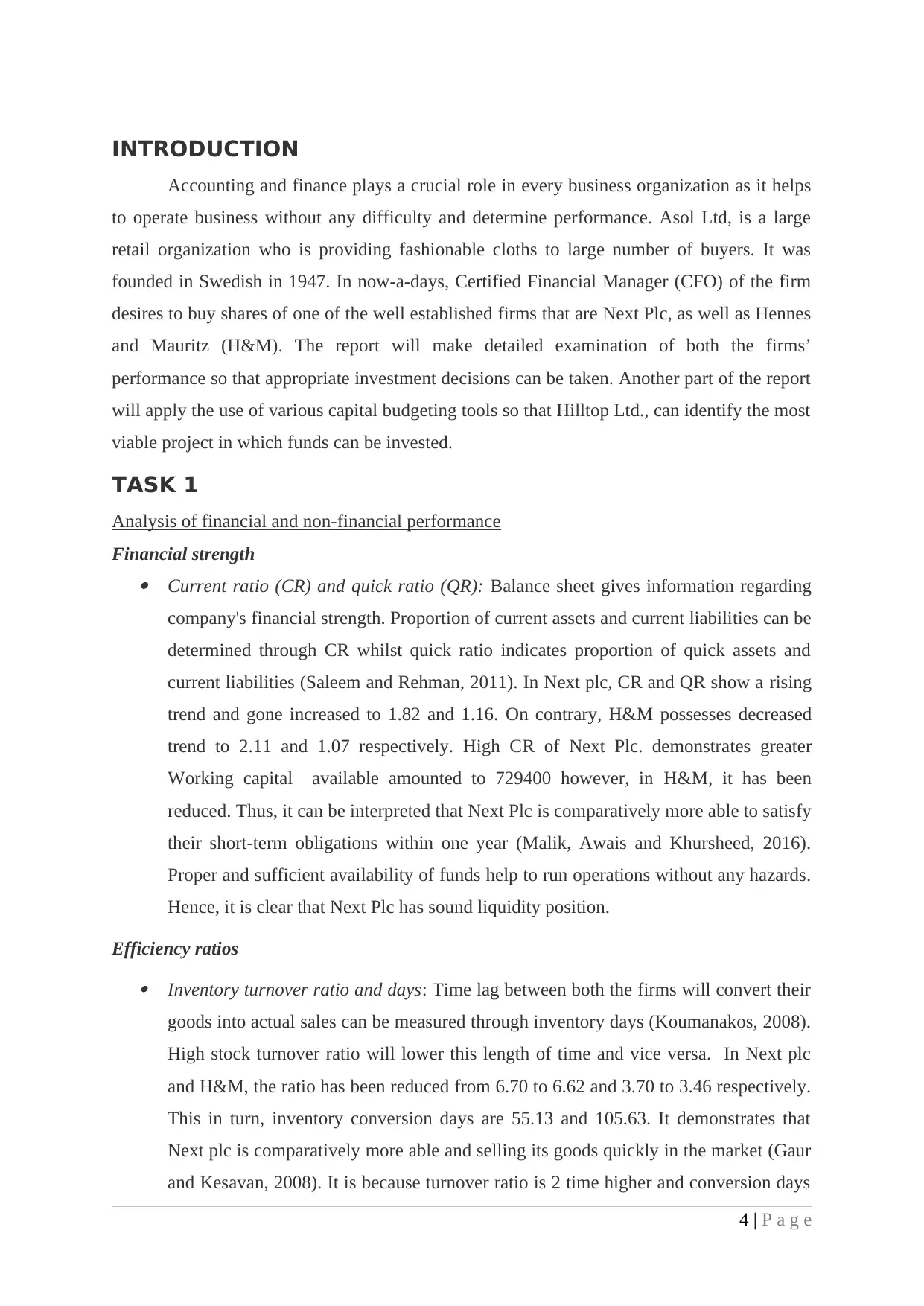
INTRODUCTION
Accounting and finance plays a crucial role in every business organization as it helps
to operate business without any difficulty and determine performance. Asol Ltd, is a large
retail organization who is providing fashionable cloths to large number of buyers. It was
founded in Swedish in 1947. In now-a-days, Certified Financial Manager (CFO) of the firm
desires to buy shares of one of the well established firms that are Next Plc, as well as Hennes
and Mauritz (H&M). The report will make detailed examination of both the firms’
performance so that appropriate investment decisions can be taken. Another part of the report
will apply the use of various capital budgeting tools so that Hilltop Ltd., can identify the most
viable project in which funds can be invested.
TASK 1
Analysis of financial and non-financial performance
Financial strength Current ratio (CR) and quick ratio (QR): Balance sheet gives information regarding
company's financial strength. Proportion of current assets and current liabilities can be
determined through CR whilst quick ratio indicates proportion of quick assets and
current liabilities (Saleem and Rehman, 2011). In Next plc, CR and QR show a rising
trend and gone increased to 1.82 and 1.16. On contrary, H&M possesses decreased
trend to 2.11 and 1.07 respectively. High CR of Next Plc. demonstrates greater
Working capital available amounted to 729400 however, in H&M, it has been
reduced. Thus, it can be interpreted that Next Plc is comparatively more able to satisfy
their short-term obligations within one year (Malik, Awais and Khursheed, 2016).
Proper and sufficient availability of funds help to run operations without any hazards.
Hence, it is clear that Next Plc has sound liquidity position.
Efficiency ratios Inventory turnover ratio and days: Time lag between both the firms will convert their
goods into actual sales can be measured through inventory days (Koumanakos, 2008).
High stock turnover ratio will lower this length of time and vice versa. In Next plc
and H&M, the ratio has been reduced from 6.70 to 6.62 and 3.70 to 3.46 respectively.
This in turn, inventory conversion days are 55.13 and 105.63. It demonstrates that
Next plc is comparatively more able and selling its goods quickly in the market (Gaur
and Kesavan, 2008). It is because turnover ratio is 2 time higher and conversion days
4 | P a g e
Accounting and finance plays a crucial role in every business organization as it helps
to operate business without any difficulty and determine performance. Asol Ltd, is a large
retail organization who is providing fashionable cloths to large number of buyers. It was
founded in Swedish in 1947. In now-a-days, Certified Financial Manager (CFO) of the firm
desires to buy shares of one of the well established firms that are Next Plc, as well as Hennes
and Mauritz (H&M). The report will make detailed examination of both the firms’
performance so that appropriate investment decisions can be taken. Another part of the report
will apply the use of various capital budgeting tools so that Hilltop Ltd., can identify the most
viable project in which funds can be invested.
TASK 1
Analysis of financial and non-financial performance
Financial strength Current ratio (CR) and quick ratio (QR): Balance sheet gives information regarding
company's financial strength. Proportion of current assets and current liabilities can be
determined through CR whilst quick ratio indicates proportion of quick assets and
current liabilities (Saleem and Rehman, 2011). In Next plc, CR and QR show a rising
trend and gone increased to 1.82 and 1.16. On contrary, H&M possesses decreased
trend to 2.11 and 1.07 respectively. High CR of Next Plc. demonstrates greater
Working capital available amounted to 729400 however, in H&M, it has been
reduced. Thus, it can be interpreted that Next Plc is comparatively more able to satisfy
their short-term obligations within one year (Malik, Awais and Khursheed, 2016).
Proper and sufficient availability of funds help to run operations without any hazards.
Hence, it is clear that Next Plc has sound liquidity position.
Efficiency ratios Inventory turnover ratio and days: Time lag between both the firms will convert their
goods into actual sales can be measured through inventory days (Koumanakos, 2008).
High stock turnover ratio will lower this length of time and vice versa. In Next plc
and H&M, the ratio has been reduced from 6.70 to 6.62 and 3.70 to 3.46 respectively.
This in turn, inventory conversion days are 55.13 and 105.63. It demonstrates that
Next plc is comparatively more able and selling its goods quickly in the market (Gaur
and Kesavan, 2008). It is because turnover ratio is 2 time higher and conversion days
4 | P a g e
Paraphrase This Document
Need a fresh take? Get an instant paraphrase of this document with our AI Paraphraser
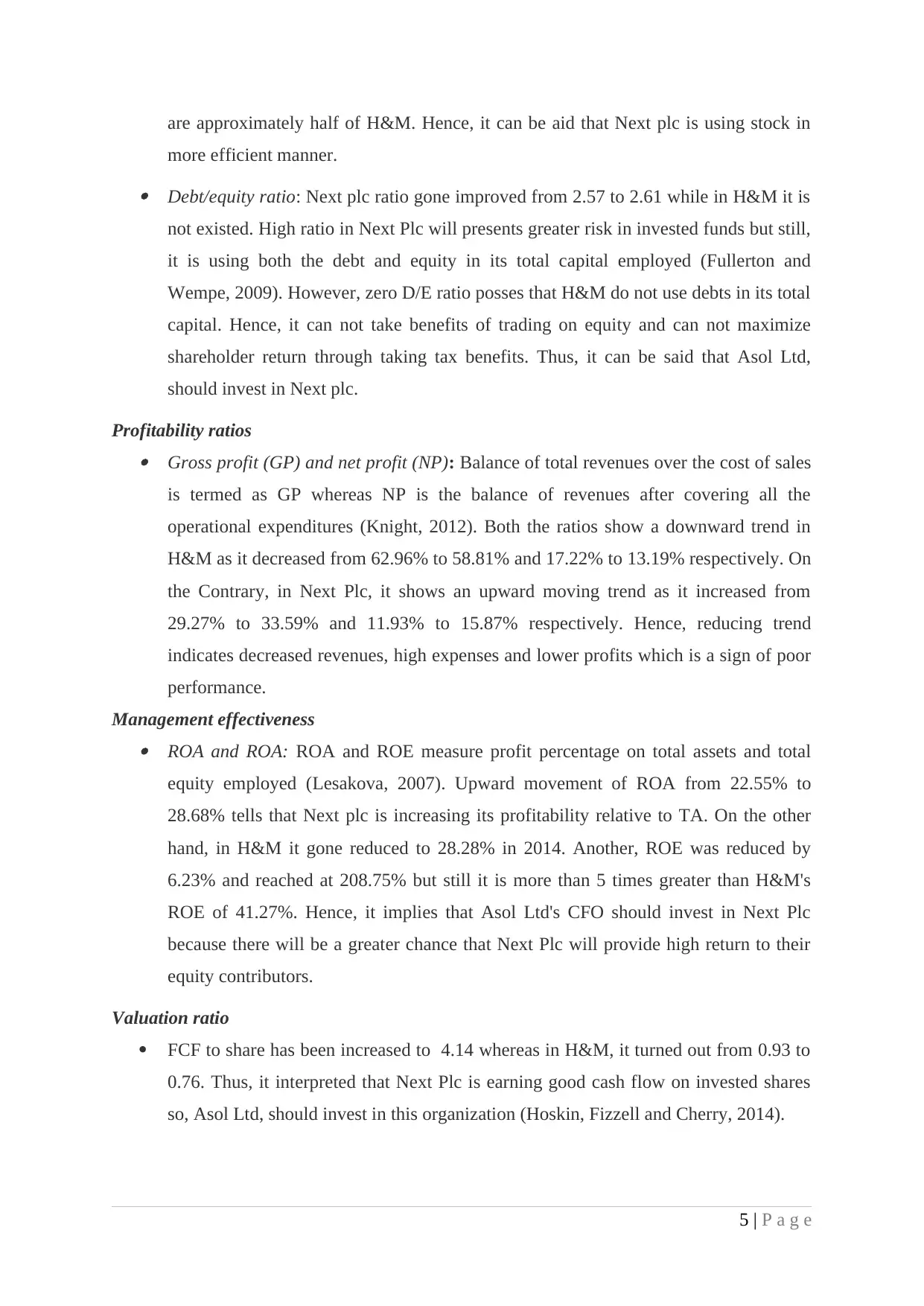
are approximately half of H&M. Hence, it can be aid that Next plc is using stock in
more efficient manner. Debt/equity ratio: Next plc ratio gone improved from 2.57 to 2.61 while in H&M it is
not existed. High ratio in Next Plc will presents greater risk in invested funds but still,
it is using both the debt and equity in its total capital employed (Fullerton and
Wempe, 2009). However, zero D/E ratio posses that H&M do not use debts in its total
capital. Hence, it can not take benefits of trading on equity and can not maximize
shareholder return through taking tax benefits. Thus, it can be said that Asol Ltd,
should invest in Next plc.
Profitability ratios Gross profit (GP) and net profit (NP): Balance of total revenues over the cost of sales
is termed as GP whereas NP is the balance of revenues after covering all the
operational expenditures (Knight, 2012). Both the ratios show a downward trend in
H&M as it decreased from 62.96% to 58.81% and 17.22% to 13.19% respectively. On
the Contrary, in Next Plc, it shows an upward moving trend as it increased from
29.27% to 33.59% and 11.93% to 15.87% respectively. Hence, reducing trend
indicates decreased revenues, high expenses and lower profits which is a sign of poor
performance.
Management effectiveness ROA and ROA: ROA and ROE measure profit percentage on total assets and total
equity employed (Lesakova, 2007). Upward movement of ROA from 22.55% to
28.68% tells that Next plc is increasing its profitability relative to TA. On the other
hand, in H&M it gone reduced to 28.28% in 2014. Another, ROE was reduced by
6.23% and reached at 208.75% but still it is more than 5 times greater than H&M's
ROE of 41.27%. Hence, it implies that Asol Ltd's CFO should invest in Next Plc
because there will be a greater chance that Next Plc will provide high return to their
equity contributors.
Valuation ratio
FCF to share has been increased to 4.14 whereas in H&M, it turned out from 0.93 to
0.76. Thus, it interpreted that Next Plc is earning good cash flow on invested shares
so, Asol Ltd, should invest in this organization (Hoskin, Fizzell and Cherry, 2014).
5 | P a g e
more efficient manner. Debt/equity ratio: Next plc ratio gone improved from 2.57 to 2.61 while in H&M it is
not existed. High ratio in Next Plc will presents greater risk in invested funds but still,
it is using both the debt and equity in its total capital employed (Fullerton and
Wempe, 2009). However, zero D/E ratio posses that H&M do not use debts in its total
capital. Hence, it can not take benefits of trading on equity and can not maximize
shareholder return through taking tax benefits. Thus, it can be said that Asol Ltd,
should invest in Next plc.
Profitability ratios Gross profit (GP) and net profit (NP): Balance of total revenues over the cost of sales
is termed as GP whereas NP is the balance of revenues after covering all the
operational expenditures (Knight, 2012). Both the ratios show a downward trend in
H&M as it decreased from 62.96% to 58.81% and 17.22% to 13.19% respectively. On
the Contrary, in Next Plc, it shows an upward moving trend as it increased from
29.27% to 33.59% and 11.93% to 15.87% respectively. Hence, reducing trend
indicates decreased revenues, high expenses and lower profits which is a sign of poor
performance.
Management effectiveness ROA and ROA: ROA and ROE measure profit percentage on total assets and total
equity employed (Lesakova, 2007). Upward movement of ROA from 22.55% to
28.68% tells that Next plc is increasing its profitability relative to TA. On the other
hand, in H&M it gone reduced to 28.28% in 2014. Another, ROE was reduced by
6.23% and reached at 208.75% but still it is more than 5 times greater than H&M's
ROE of 41.27%. Hence, it implies that Asol Ltd's CFO should invest in Next Plc
because there will be a greater chance that Next Plc will provide high return to their
equity contributors.
Valuation ratio
FCF to share has been increased to 4.14 whereas in H&M, it turned out from 0.93 to
0.76. Thus, it interpreted that Next Plc is earning good cash flow on invested shares
so, Asol Ltd, should invest in this organization (Hoskin, Fizzell and Cherry, 2014).
5 | P a g e
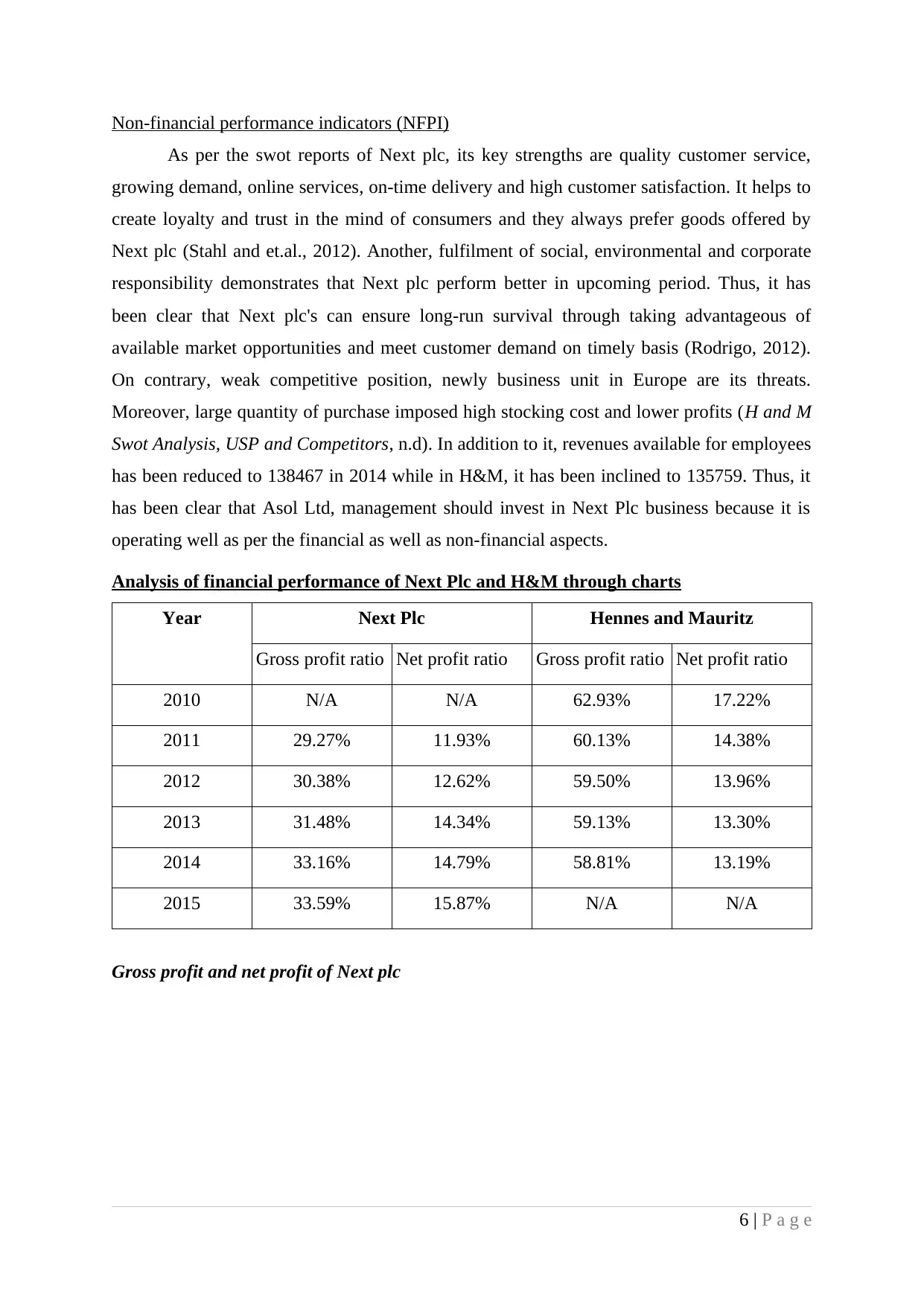
Non-financial performance indicators (NFPI)
As per the swot reports of Next plc, its key strengths are quality customer service,
growing demand, online services, on-time delivery and high customer satisfaction. It helps to
create loyalty and trust in the mind of consumers and they always prefer goods offered by
Next plc (Stahl and et.al., 2012). Another, fulfilment of social, environmental and corporate
responsibility demonstrates that Next plc perform better in upcoming period. Thus, it has
been clear that Next plc's can ensure long-run survival through taking advantageous of
available market opportunities and meet customer demand on timely basis (Rodrigo, 2012).
On contrary, weak competitive position, newly business unit in Europe are its threats.
Moreover, large quantity of purchase imposed high stocking cost and lower profits (H and M
Swot Analysis, USP and Competitors, n.d). In addition to it, revenues available for employees
has been reduced to 138467 in 2014 while in H&M, it has been inclined to 135759. Thus, it
has been clear that Asol Ltd, management should invest in Next Plc business because it is
operating well as per the financial as well as non-financial aspects.
Analysis of financial performance of Next Plc and H&M through charts
Year Next Plc Hennes and Mauritz
Gross profit ratio Net profit ratio Gross profit ratio Net profit ratio
2010 N/A N/A 62.93% 17.22%
2011 29.27% 11.93% 60.13% 14.38%
2012 30.38% 12.62% 59.50% 13.96%
2013 31.48% 14.34% 59.13% 13.30%
2014 33.16% 14.79% 58.81% 13.19%
2015 33.59% 15.87% N/A N/A
Gross profit and net profit of Next plc
6 | P a g e
As per the swot reports of Next plc, its key strengths are quality customer service,
growing demand, online services, on-time delivery and high customer satisfaction. It helps to
create loyalty and trust in the mind of consumers and they always prefer goods offered by
Next plc (Stahl and et.al., 2012). Another, fulfilment of social, environmental and corporate
responsibility demonstrates that Next plc perform better in upcoming period. Thus, it has
been clear that Next plc's can ensure long-run survival through taking advantageous of
available market opportunities and meet customer demand on timely basis (Rodrigo, 2012).
On contrary, weak competitive position, newly business unit in Europe are its threats.
Moreover, large quantity of purchase imposed high stocking cost and lower profits (H and M
Swot Analysis, USP and Competitors, n.d). In addition to it, revenues available for employees
has been reduced to 138467 in 2014 while in H&M, it has been inclined to 135759. Thus, it
has been clear that Asol Ltd, management should invest in Next Plc business because it is
operating well as per the financial as well as non-financial aspects.
Analysis of financial performance of Next Plc and H&M through charts
Year Next Plc Hennes and Mauritz
Gross profit ratio Net profit ratio Gross profit ratio Net profit ratio
2010 N/A N/A 62.93% 17.22%
2011 29.27% 11.93% 60.13% 14.38%
2012 30.38% 12.62% 59.50% 13.96%
2013 31.48% 14.34% 59.13% 13.30%
2014 33.16% 14.79% 58.81% 13.19%
2015 33.59% 15.87% N/A N/A
Gross profit and net profit of Next plc
6 | P a g e
⊘ This is a preview!⊘
Do you want full access?
Subscribe today to unlock all pages.

Trusted by 1+ million students worldwide
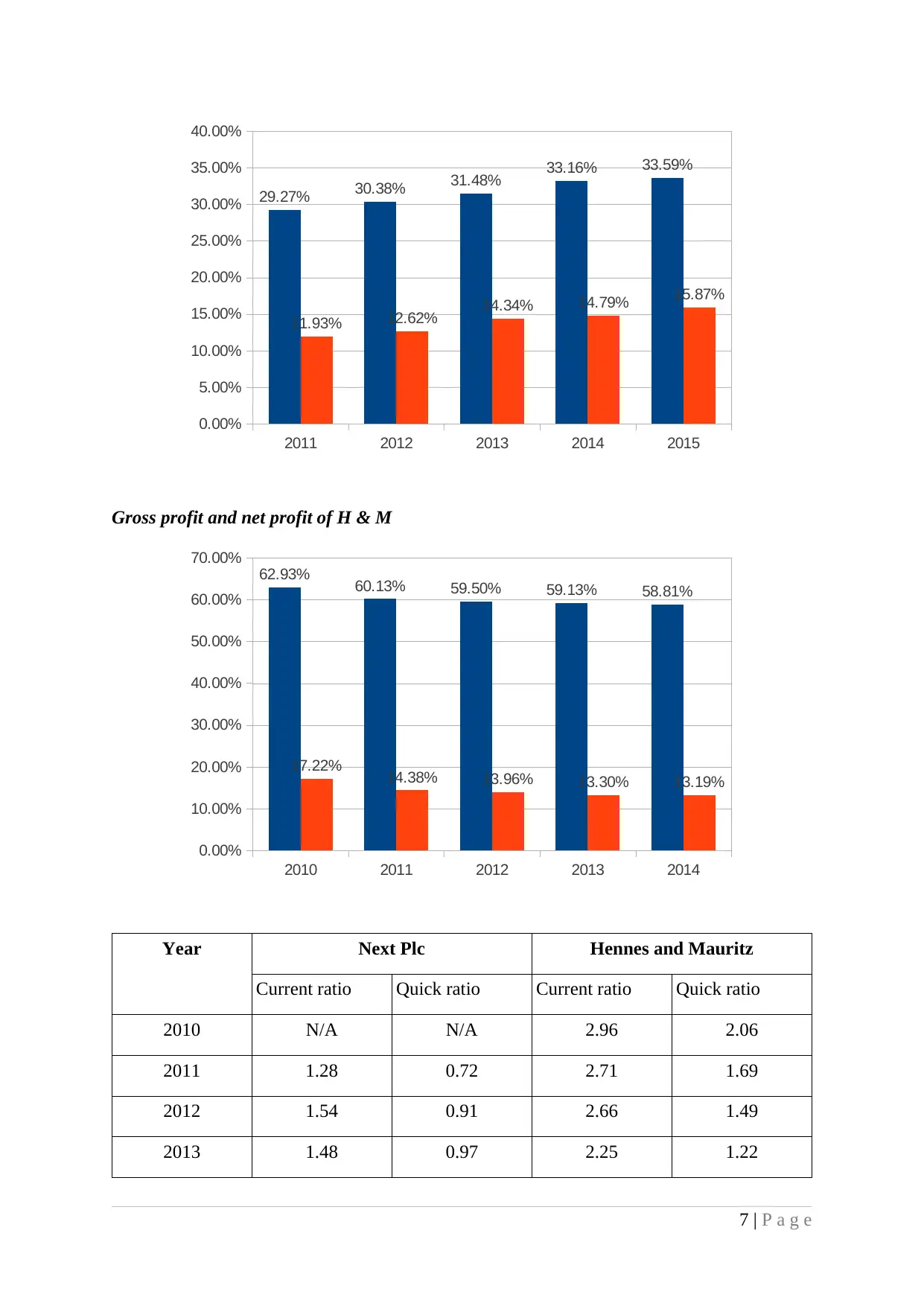
Gross profit and net profit of H & M
Year Next Plc Hennes and Mauritz
Current ratio Quick ratio Current ratio Quick ratio
2010 N/A N/A 2.96 2.06
2011 1.28 0.72 2.71 1.69
2012 1.54 0.91 2.66 1.49
2013 1.48 0.97 2.25 1.22
7 | P a g e
2011 2012 2013 2014 2015
0.00%
5.00%
10.00%
15.00%
20.00%
25.00%
30.00%
35.00%
40.00%
29.27% 30.38% 31.48% 33.16% 33.59%
11.93% 12.62% 14.34% 14.79% 15.87%
2010 2011 2012 2013 2014
0.00%
10.00%
20.00%
30.00%
40.00%
50.00%
60.00%
70.00%
62.93% 60.13% 59.50% 59.13% 58.81%
17.22% 14.38% 13.96% 13.30% 13.19%
Year Next Plc Hennes and Mauritz
Current ratio Quick ratio Current ratio Quick ratio
2010 N/A N/A 2.96 2.06
2011 1.28 0.72 2.71 1.69
2012 1.54 0.91 2.66 1.49
2013 1.48 0.97 2.25 1.22
7 | P a g e
2011 2012 2013 2014 2015
0.00%
5.00%
10.00%
15.00%
20.00%
25.00%
30.00%
35.00%
40.00%
29.27% 30.38% 31.48% 33.16% 33.59%
11.93% 12.62% 14.34% 14.79% 15.87%
2010 2011 2012 2013 2014
0.00%
10.00%
20.00%
30.00%
40.00%
50.00%
60.00%
70.00%
62.93% 60.13% 59.50% 59.13% 58.81%
17.22% 14.38% 13.96% 13.30% 13.19%
Paraphrase This Document
Need a fresh take? Get an instant paraphrase of this document with our AI Paraphraser
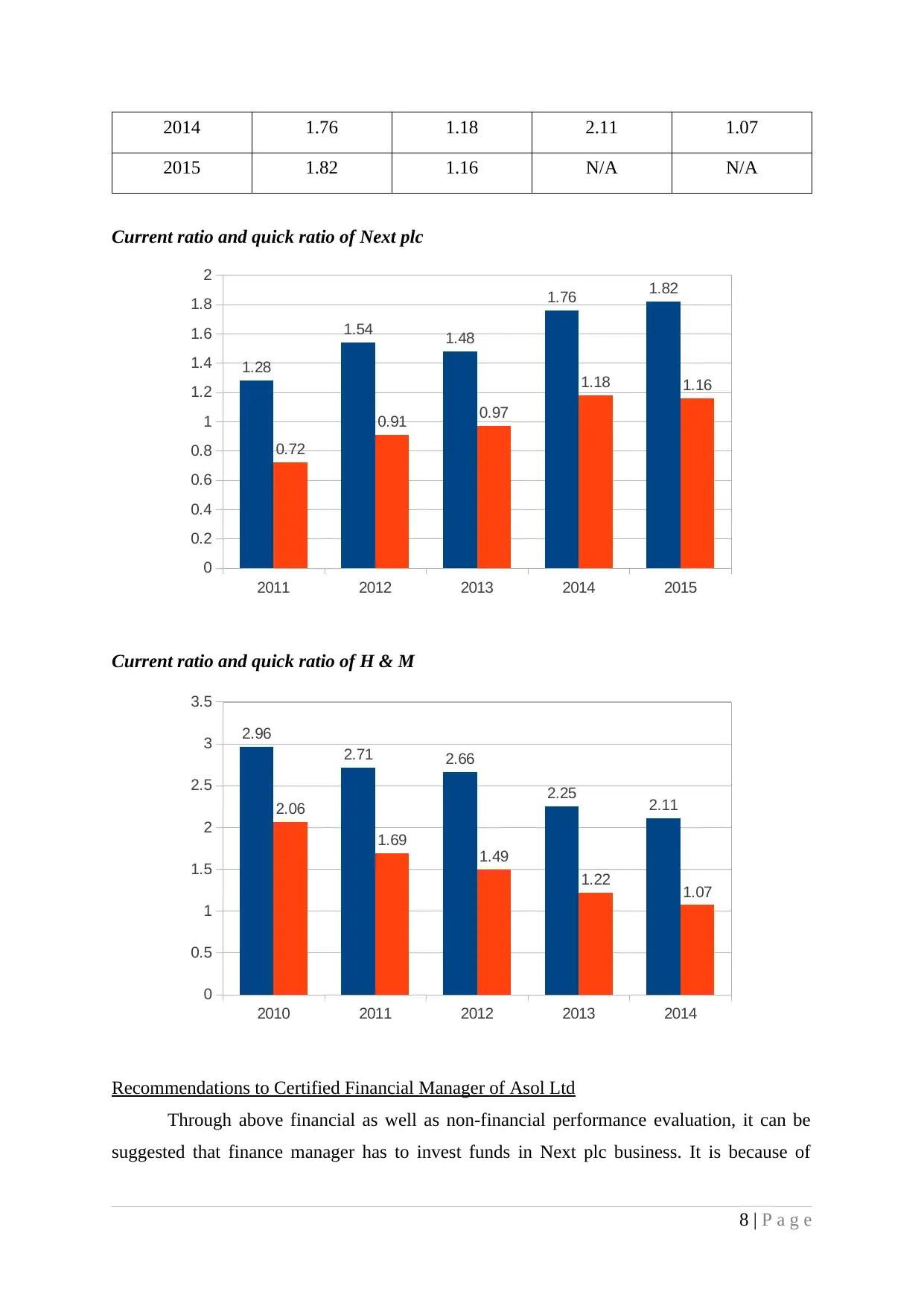
2014 1.76 1.18 2.11 1.07
2015 1.82 1.16 N/A N/A
Current ratio and quick ratio of Next plc
Current ratio and quick ratio of H & M
Recommendations to Certified Financial Manager of Asol Ltd
Through above financial as well as non-financial performance evaluation, it can be
suggested that finance manager has to invest funds in Next plc business. It is because of
8 | P a g e
2011 2012 2013 2014 2015
0
0.2
0.4
0.6
0.8
1
1.2
1.4
1.6
1.8
2
1.28
1.54 1.48
1.76 1.82
0.72
0.91 0.97
1.18 1.16
2010 2011 2012 2013 2014
0
0.5
1
1.5
2
2.5
3
3.5
2.96
2.71 2.66
2.25 2.112.06
1.69
1.49
1.22 1.07
2015 1.82 1.16 N/A N/A
Current ratio and quick ratio of Next plc
Current ratio and quick ratio of H & M
Recommendations to Certified Financial Manager of Asol Ltd
Through above financial as well as non-financial performance evaluation, it can be
suggested that finance manager has to invest funds in Next plc business. It is because of
8 | P a g e
2011 2012 2013 2014 2015
0
0.2
0.4
0.6
0.8
1
1.2
1.4
1.6
1.8
2
1.28
1.54 1.48
1.76 1.82
0.72
0.91 0.97
1.18 1.16
2010 2011 2012 2013 2014
0
0.5
1
1.5
2
2.5
3
3.5
2.96
2.71 2.66
2.25 2.112.06
1.69
1.49
1.22 1.07
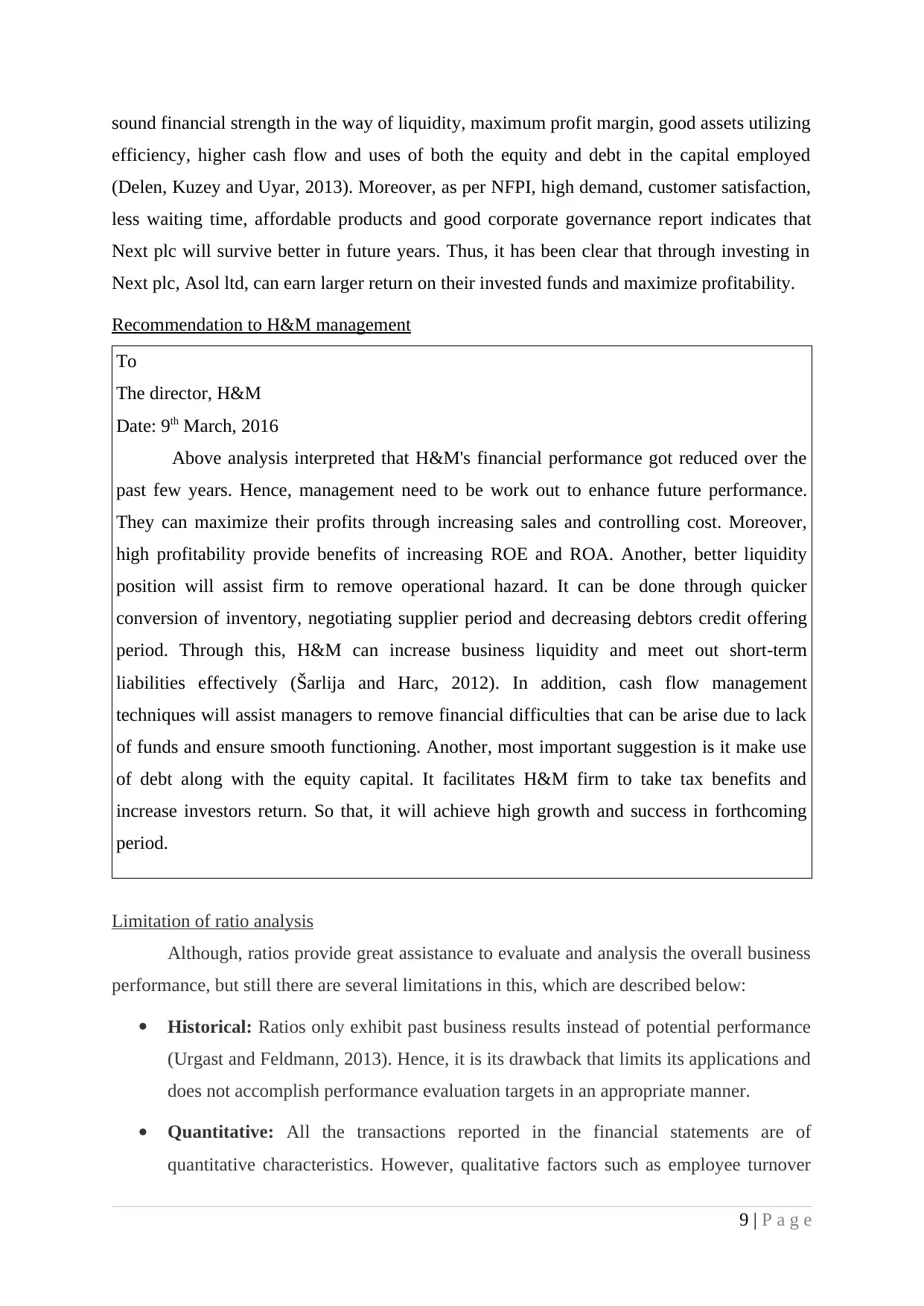
sound financial strength in the way of liquidity, maximum profit margin, good assets utilizing
efficiency, higher cash flow and uses of both the equity and debt in the capital employed
(Delen, Kuzey and Uyar, 2013). Moreover, as per NFPI, high demand, customer satisfaction,
less waiting time, affordable products and good corporate governance report indicates that
Next plc will survive better in future years. Thus, it has been clear that through investing in
Next plc, Asol ltd, can earn larger return on their invested funds and maximize profitability.
Recommendation to H&M management
To
The director, H&M
Date: 9th March, 2016
Above analysis interpreted that H&M's financial performance got reduced over the
past few years. Hence, management need to be work out to enhance future performance.
They can maximize their profits through increasing sales and controlling cost. Moreover,
high profitability provide benefits of increasing ROE and ROA. Another, better liquidity
position will assist firm to remove operational hazard. It can be done through quicker
conversion of inventory, negotiating supplier period and decreasing debtors credit offering
period. Through this, H&M can increase business liquidity and meet out short-term
liabilities effectively (Šarlija and Harc, 2012). In addition, cash flow management
techniques will assist managers to remove financial difficulties that can be arise due to lack
of funds and ensure smooth functioning. Another, most important suggestion is it make use
of debt along with the equity capital. It facilitates H&M firm to take tax benefits and
increase investors return. So that, it will achieve high growth and success in forthcoming
period.
Limitation of ratio analysis
Although, ratios provide great assistance to evaluate and analysis the overall business
performance, but still there are several limitations in this, which are described below:
Historical: Ratios only exhibit past business results instead of potential performance
(Urgast and Feldmann, 2013). Hence, it is its drawback that limits its applications and
does not accomplish performance evaluation targets in an appropriate manner.
Quantitative: All the transactions reported in the financial statements are of
quantitative characteristics. However, qualitative factors such as employee turnover
9 | P a g e
efficiency, higher cash flow and uses of both the equity and debt in the capital employed
(Delen, Kuzey and Uyar, 2013). Moreover, as per NFPI, high demand, customer satisfaction,
less waiting time, affordable products and good corporate governance report indicates that
Next plc will survive better in future years. Thus, it has been clear that through investing in
Next plc, Asol ltd, can earn larger return on their invested funds and maximize profitability.
Recommendation to H&M management
To
The director, H&M
Date: 9th March, 2016
Above analysis interpreted that H&M's financial performance got reduced over the
past few years. Hence, management need to be work out to enhance future performance.
They can maximize their profits through increasing sales and controlling cost. Moreover,
high profitability provide benefits of increasing ROE and ROA. Another, better liquidity
position will assist firm to remove operational hazard. It can be done through quicker
conversion of inventory, negotiating supplier period and decreasing debtors credit offering
period. Through this, H&M can increase business liquidity and meet out short-term
liabilities effectively (Šarlija and Harc, 2012). In addition, cash flow management
techniques will assist managers to remove financial difficulties that can be arise due to lack
of funds and ensure smooth functioning. Another, most important suggestion is it make use
of debt along with the equity capital. It facilitates H&M firm to take tax benefits and
increase investors return. So that, it will achieve high growth and success in forthcoming
period.
Limitation of ratio analysis
Although, ratios provide great assistance to evaluate and analysis the overall business
performance, but still there are several limitations in this, which are described below:
Historical: Ratios only exhibit past business results instead of potential performance
(Urgast and Feldmann, 2013). Hence, it is its drawback that limits its applications and
does not accomplish performance evaluation targets in an appropriate manner.
Quantitative: All the transactions reported in the financial statements are of
quantitative characteristics. However, qualitative factors such as employee turnover
9 | P a g e
⊘ This is a preview!⊘
Do you want full access?
Subscribe today to unlock all pages.

Trusted by 1+ million students worldwide
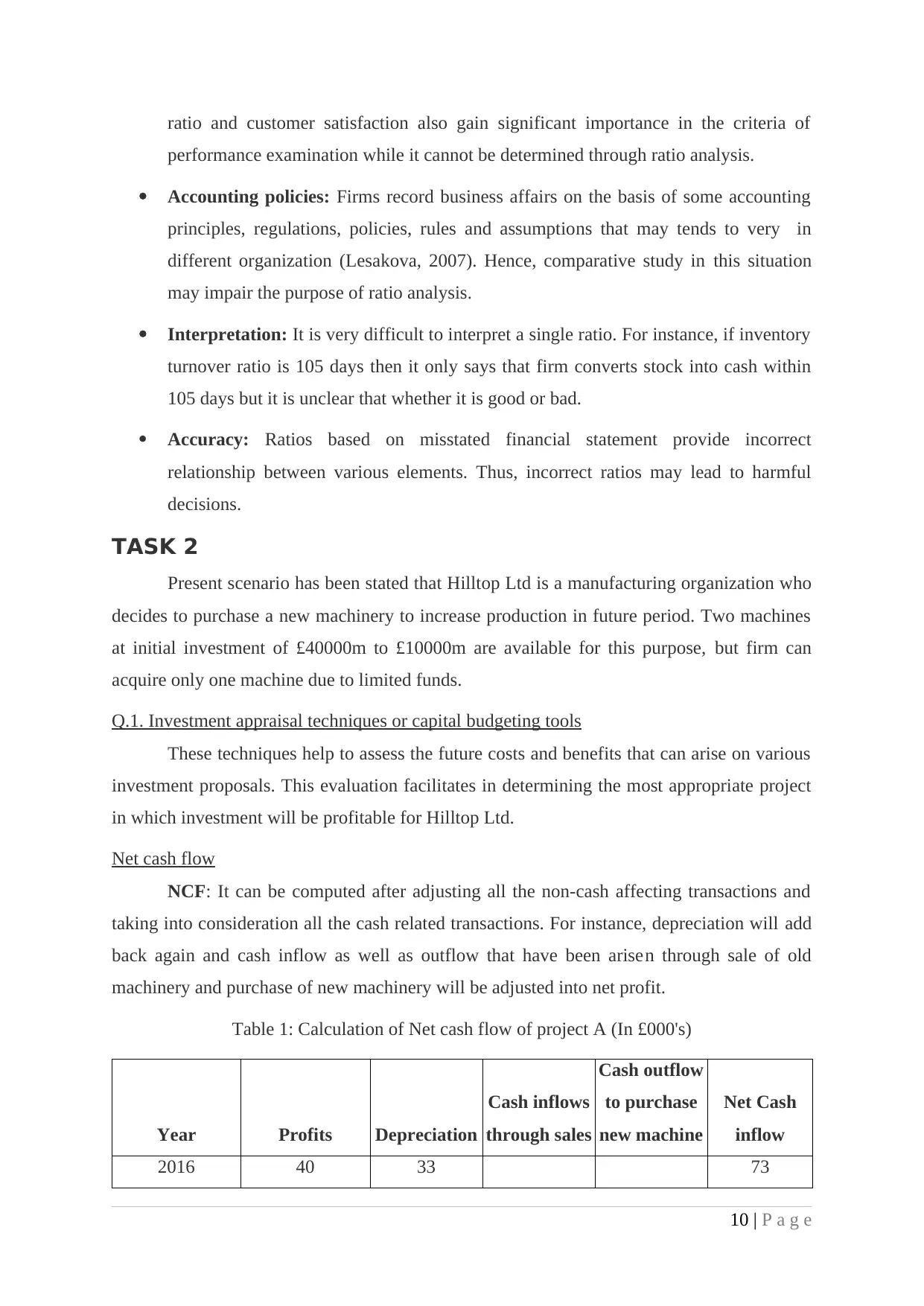
ratio and customer satisfaction also gain significant importance in the criteria of
performance examination while it cannot be determined through ratio analysis.
Accounting policies: Firms record business affairs on the basis of some accounting
principles, regulations, policies, rules and assumptions that may tends to very in
different organization (Lesakova, 2007). Hence, comparative study in this situation
may impair the purpose of ratio analysis.
Interpretation: It is very difficult to interpret a single ratio. For instance, if inventory
turnover ratio is 105 days then it only says that firm converts stock into cash within
105 days but it is unclear that whether it is good or bad.
Accuracy: Ratios based on misstated financial statement provide incorrect
relationship between various elements. Thus, incorrect ratios may lead to harmful
decisions.
TASK 2
Present scenario has been stated that Hilltop Ltd is a manufacturing organization who
decides to purchase a new machinery to increase production in future period. Two machines
at initial investment of £40000m to £10000m are available for this purpose, but firm can
acquire only one machine due to limited funds.
Q.1. Investment appraisal techniques or capital budgeting tools
These techniques help to assess the future costs and benefits that can arise on various
investment proposals. This evaluation facilitates in determining the most appropriate project
in which investment will be profitable for Hilltop Ltd.
Net cash flow
NCF: It can be computed after adjusting all the non-cash affecting transactions and
taking into consideration all the cash related transactions. For instance, depreciation will add
back again and cash inflow as well as outflow that have been arisen through sale of old
machinery and purchase of new machinery will be adjusted into net profit.
Table 1: Calculation of Net cash flow of project A (In £000's)
Year Profits Depreciation
Cash inflows
through sales
Cash outflow
to purchase
new machine
Net Cash
inflow
2016 40 33 73
10 | P a g e
performance examination while it cannot be determined through ratio analysis.
Accounting policies: Firms record business affairs on the basis of some accounting
principles, regulations, policies, rules and assumptions that may tends to very in
different organization (Lesakova, 2007). Hence, comparative study in this situation
may impair the purpose of ratio analysis.
Interpretation: It is very difficult to interpret a single ratio. For instance, if inventory
turnover ratio is 105 days then it only says that firm converts stock into cash within
105 days but it is unclear that whether it is good or bad.
Accuracy: Ratios based on misstated financial statement provide incorrect
relationship between various elements. Thus, incorrect ratios may lead to harmful
decisions.
TASK 2
Present scenario has been stated that Hilltop Ltd is a manufacturing organization who
decides to purchase a new machinery to increase production in future period. Two machines
at initial investment of £40000m to £10000m are available for this purpose, but firm can
acquire only one machine due to limited funds.
Q.1. Investment appraisal techniques or capital budgeting tools
These techniques help to assess the future costs and benefits that can arise on various
investment proposals. This evaluation facilitates in determining the most appropriate project
in which investment will be profitable for Hilltop Ltd.
Net cash flow
NCF: It can be computed after adjusting all the non-cash affecting transactions and
taking into consideration all the cash related transactions. For instance, depreciation will add
back again and cash inflow as well as outflow that have been arisen through sale of old
machinery and purchase of new machinery will be adjusted into net profit.
Table 1: Calculation of Net cash flow of project A (In £000's)
Year Profits Depreciation
Cash inflows
through sales
Cash outflow
to purchase
new machine
Net Cash
inflow
2016 40 33 73
10 | P a g e
Paraphrase This Document
Need a fresh take? Get an instant paraphrase of this document with our AI Paraphraser
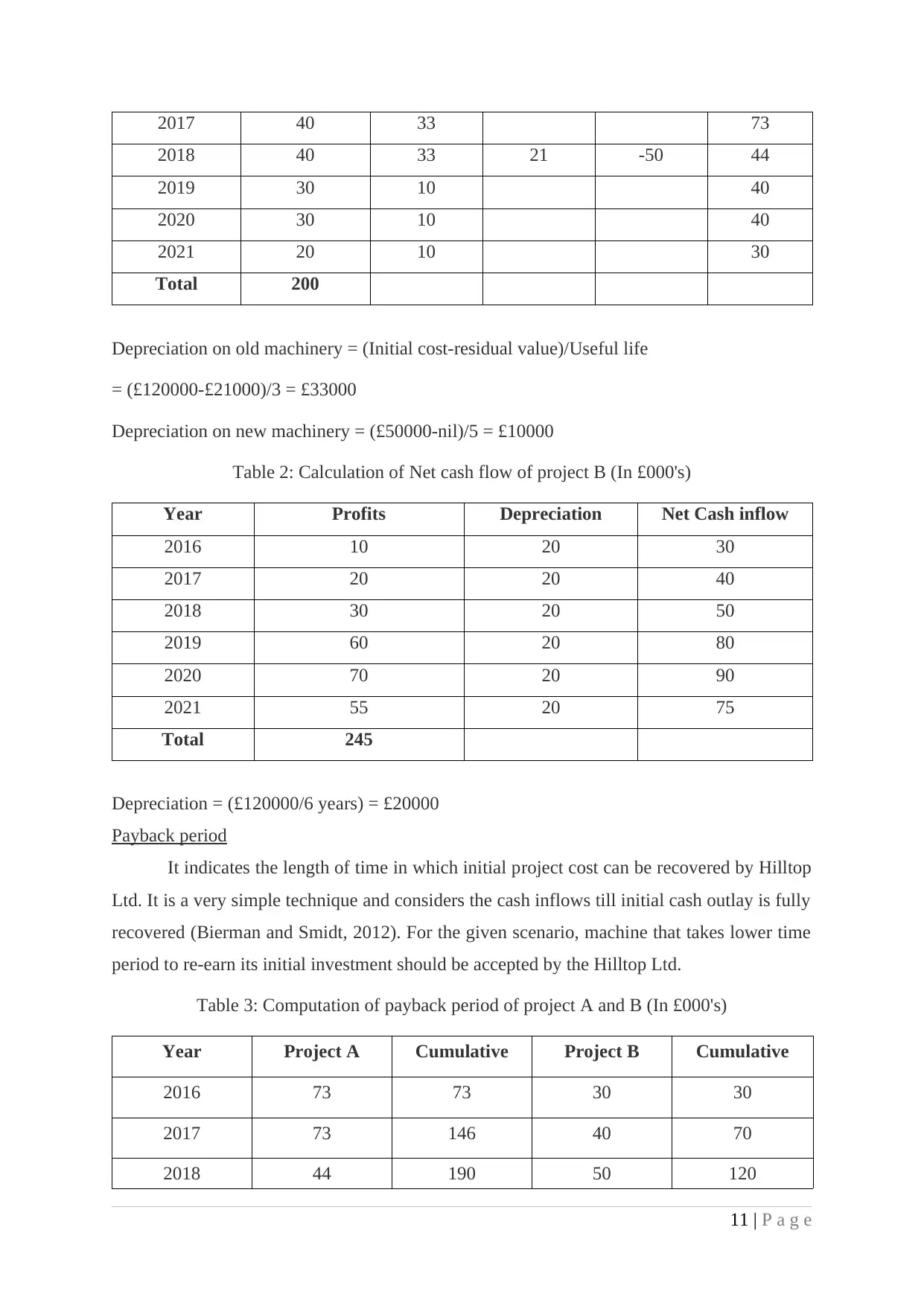
2017 40 33 73
2018 40 33 21 -50 44
2019 30 10 40
2020 30 10 40
2021 20 10 30
Total 200
Depreciation on old machinery = (Initial cost-residual value)/Useful life
= (£120000-£21000)/3 = £33000
Depreciation on new machinery = (£50000-nil)/5 = £10000
Table 2: Calculation of Net cash flow of project B (In £000's)
Year Profits Depreciation Net Cash inflow
2016 10 20 30
2017 20 20 40
2018 30 20 50
2019 60 20 80
2020 70 20 90
2021 55 20 75
Total 245
Depreciation = (£120000/6 years) = £20000
Payback period
It indicates the length of time in which initial project cost can be recovered by Hilltop
Ltd. It is a very simple technique and considers the cash inflows till initial cash outlay is fully
recovered (Bierman and Smidt, 2012). For the given scenario, machine that takes lower time
period to re-earn its initial investment should be accepted by the Hilltop Ltd.
Table 3: Computation of payback period of project A and B (In £000's)
Year Project A Cumulative Project B Cumulative
2016 73 73 30 30
2017 73 146 40 70
2018 44 190 50 120
11 | P a g e
2018 40 33 21 -50 44
2019 30 10 40
2020 30 10 40
2021 20 10 30
Total 200
Depreciation on old machinery = (Initial cost-residual value)/Useful life
= (£120000-£21000)/3 = £33000
Depreciation on new machinery = (£50000-nil)/5 = £10000
Table 2: Calculation of Net cash flow of project B (In £000's)
Year Profits Depreciation Net Cash inflow
2016 10 20 30
2017 20 20 40
2018 30 20 50
2019 60 20 80
2020 70 20 90
2021 55 20 75
Total 245
Depreciation = (£120000/6 years) = £20000
Payback period
It indicates the length of time in which initial project cost can be recovered by Hilltop
Ltd. It is a very simple technique and considers the cash inflows till initial cash outlay is fully
recovered (Bierman and Smidt, 2012). For the given scenario, machine that takes lower time
period to re-earn its initial investment should be accepted by the Hilltop Ltd.
Table 3: Computation of payback period of project A and B (In £000's)
Year Project A Cumulative Project B Cumulative
2016 73 73 30 30
2017 73 146 40 70
2018 44 190 50 120
11 | P a g e
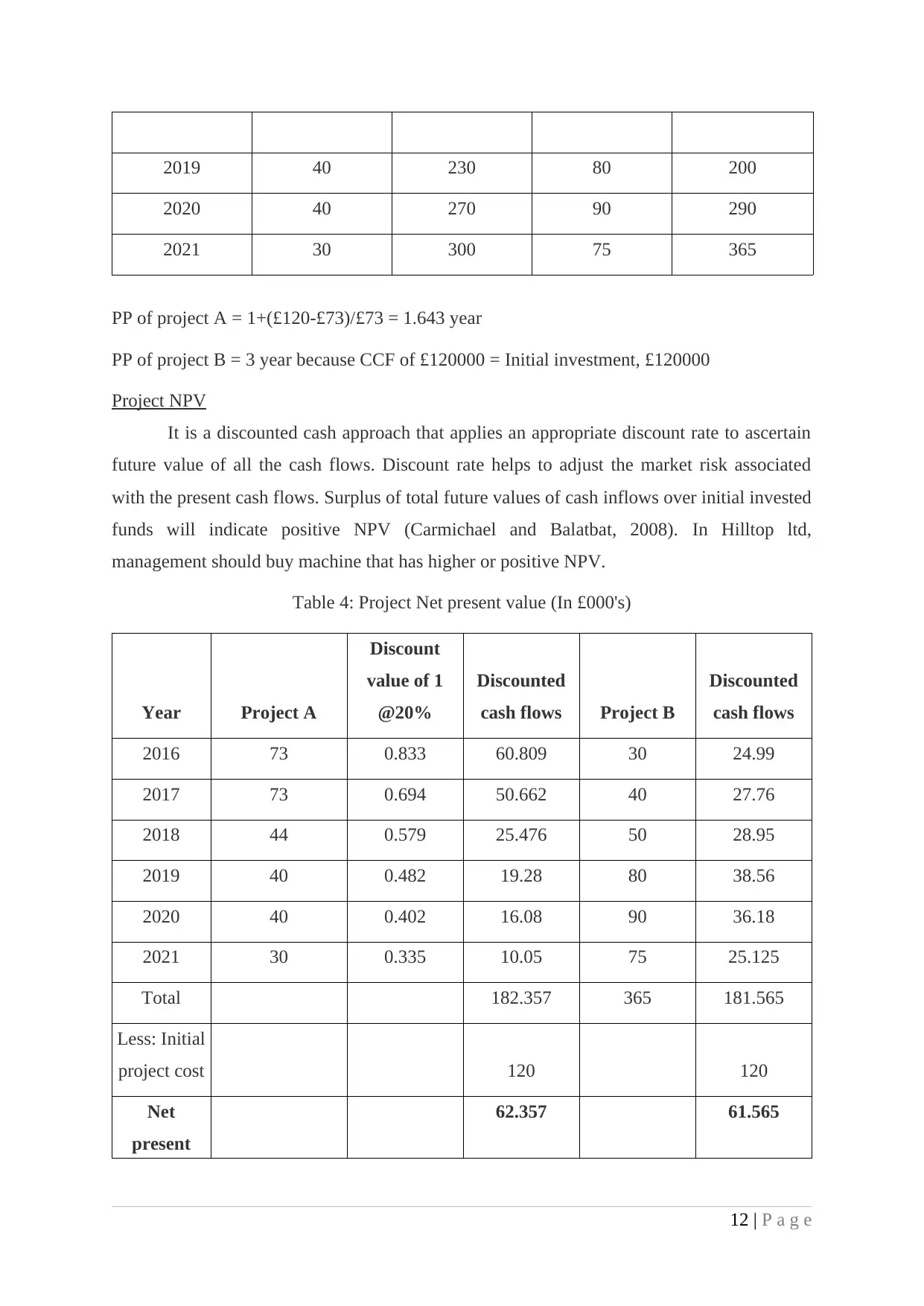
2019 40 230 80 200
2020 40 270 90 290
2021 30 300 75 365
PP of project A = 1+(£120-£73)/£73 = 1.643 year
PP of project B = 3 year because CCF of £120000 = Initial investment, £120000
Project NPV
It is a discounted cash approach that applies an appropriate discount rate to ascertain
future value of all the cash flows. Discount rate helps to adjust the market risk associated
with the present cash flows. Surplus of total future values of cash inflows over initial invested
funds will indicate positive NPV (Carmichael and Balatbat, 2008). In Hilltop ltd,
management should buy machine that has higher or positive NPV.
Table 4: Project Net present value (In £000's)
Year Project A
Discount
value of 1
@20%
Discounted
cash flows Project B
Discounted
cash flows
2016 73 0.833 60.809 30 24.99
2017 73 0.694 50.662 40 27.76
2018 44 0.579 25.476 50 28.95
2019 40 0.482 19.28 80 38.56
2020 40 0.402 16.08 90 36.18
2021 30 0.335 10.05 75 25.125
Total 182.357 365 181.565
Less: Initial
project cost 120 120
Net
present
62.357 61.565
12 | P a g e
2020 40 270 90 290
2021 30 300 75 365
PP of project A = 1+(£120-£73)/£73 = 1.643 year
PP of project B = 3 year because CCF of £120000 = Initial investment, £120000
Project NPV
It is a discounted cash approach that applies an appropriate discount rate to ascertain
future value of all the cash flows. Discount rate helps to adjust the market risk associated
with the present cash flows. Surplus of total future values of cash inflows over initial invested
funds will indicate positive NPV (Carmichael and Balatbat, 2008). In Hilltop ltd,
management should buy machine that has higher or positive NPV.
Table 4: Project Net present value (In £000's)
Year Project A
Discount
value of 1
@20%
Discounted
cash flows Project B
Discounted
cash flows
2016 73 0.833 60.809 30 24.99
2017 73 0.694 50.662 40 27.76
2018 44 0.579 25.476 50 28.95
2019 40 0.482 19.28 80 38.56
2020 40 0.402 16.08 90 36.18
2021 30 0.335 10.05 75 25.125
Total 182.357 365 181.565
Less: Initial
project cost 120 120
Net
present
62.357 61.565
12 | P a g e
⊘ This is a preview!⊘
Do you want full access?
Subscribe today to unlock all pages.

Trusted by 1+ million students worldwide
1 out of 16
Related Documents
Your All-in-One AI-Powered Toolkit for Academic Success.
+13062052269
info@desklib.com
Available 24*7 on WhatsApp / Email
![[object Object]](/_next/static/media/star-bottom.7253800d.svg)
Unlock your academic potential
Copyright © 2020–2025 A2Z Services. All Rights Reserved. Developed and managed by ZUCOL.





